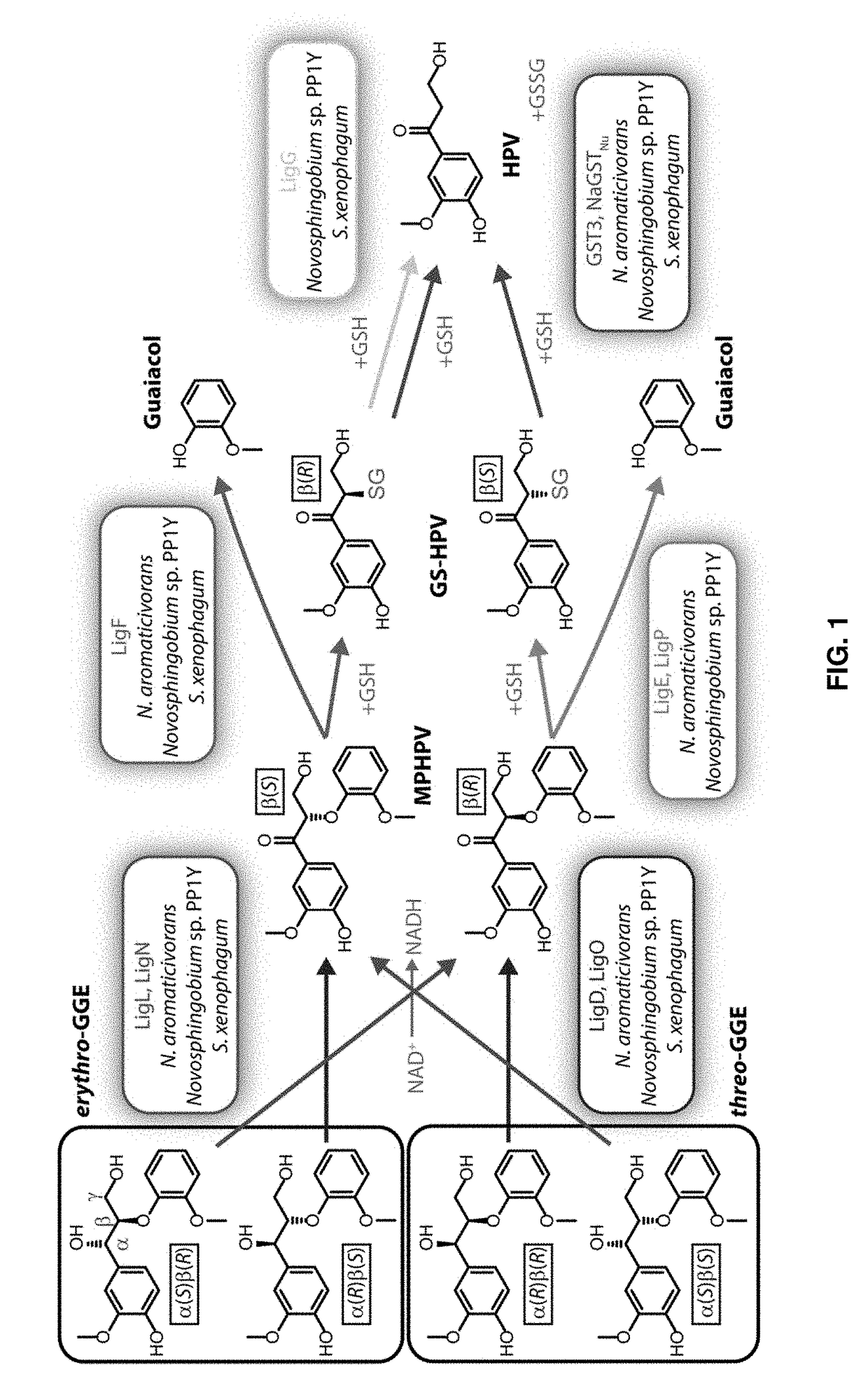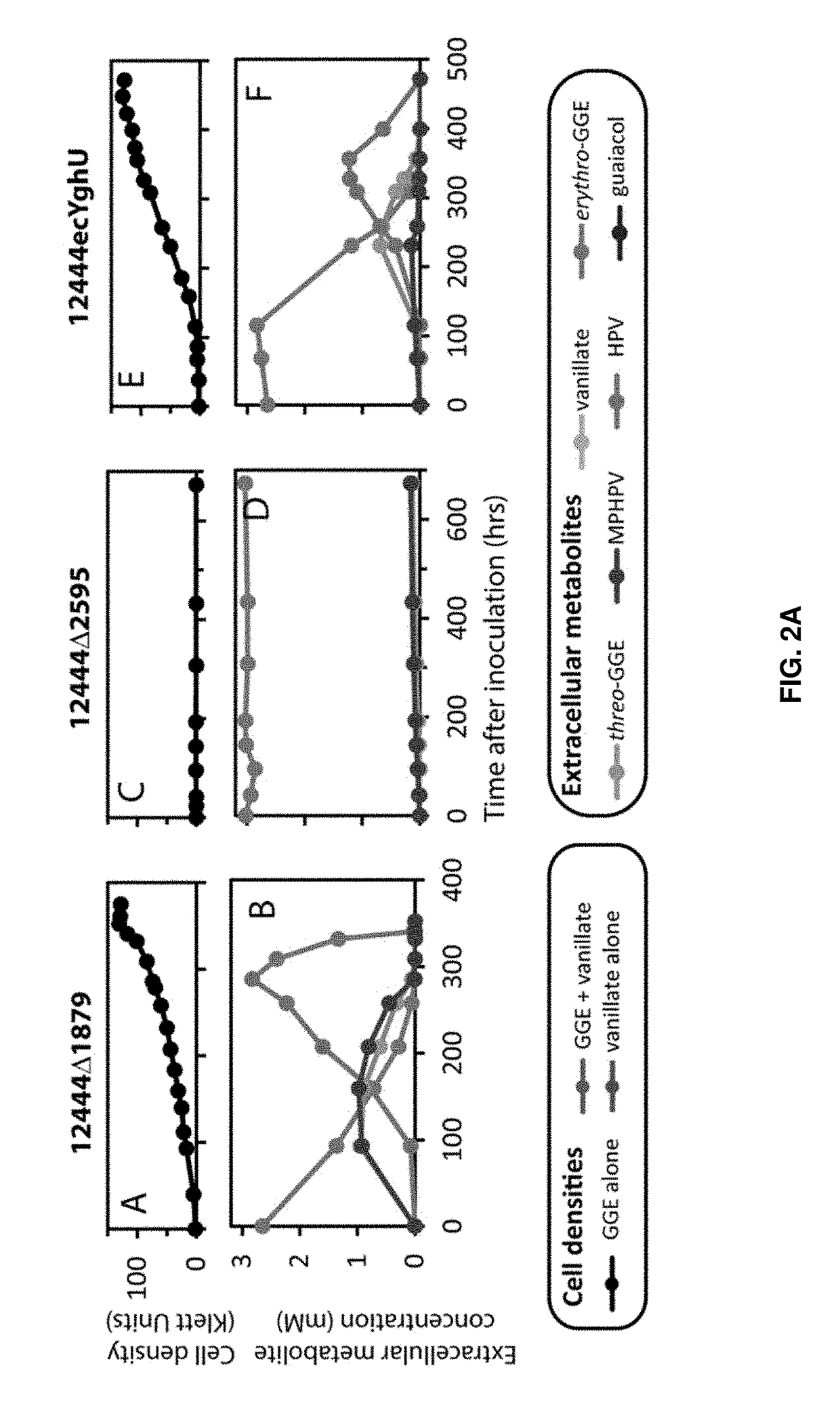Enzymes and methods for processing lignin and other aromatic compounds
a technology of lignin and enzymology, applied in the field of enzymology, can solve the problems of difficult depolymerization, high temperature or pressure, and difficult depolymerization of lignin into simpler compounds, and achieve the effect of facilitating downstream processing
- Summary
- Abstract
- Description
- Claims
- Application Information
AI Technical Summary
Benefits of technology
Problems solved by technology
Method used
Image
Examples
example 1
Nu-Class Glutathione-S-Transferases can Act as Glutathione Lyases in the Bacterial Pathway for Breaking β-Aryl Ether Bonds in Lignin
Summary
[0086]As a major component of plant cells walls, lignin is a potential renewable source of valuable chemicals. Several sphingomonad bacteria have been identified that can use glutathione to break the β-aryl ether bond commonly found between phenylpropanoid units of the lignin heteropolymer. To explore bacterial strategies for depolymerizing lignin, we tested the abilities of three sphingomonads to metabolize the β-aryl ether containing dimeric aromatic compound guaiacylglycerol-β-guaiacyl ether (GGE). We found that Novo-sphingobium aromaticivorans metabolized GGE at amongst the fastest rates thus far reported. After the β-aryl ether bond of GGE is broken, the glutathione moiety must be removed from the resultant phenylpropanoid conjugate (α-glutathionyl-β-hydroxypropio-vanillone (GS-HPV)). We found that a Nu-class glutathione-S-transferase (GST) ...
example 2
[0206]In Vitro Enzymatic Release of Syringyl, Guaiacyl, and Tricin Units from Lignin
Summary
[0207]New information and processes are needed to derive valuable compounds from renewable resources. Lignin is an abundant, heterogeneous, and racemic polymer in terrestrial plants, and it is comprised predominantly of guaiacyl and syringyl monoaromatic phenylpropanoid units that are covalently linked together in a purely chemical radical coupling polymerization process. In addition, the plant secondary metabolite, tricin, is a recently found and abundant lignin monomer in grasses. The most prevalent type of inter-unit linkage between guaiacyl, syringyl, and tricin units is the β-ether linkage. Previous studies have shown that enzymes in the bacterial β-etherase pathway catalyze glutathione-dependent cleavage of β-ether bonds in dimeric β-ether lignin model compounds, resulting in the release of monoaromatic products, the reduction of nicotinamide adenine dinucleotide (NAD+) to NADH, and the ...
example 3
A Heterodimeric β-Etherase Capable of Sterospecifically Breaking the β-Aryl Ether Bond Commonly Found in Lignin
Summary
[0243]This example describes a newly identified enzyme that can cleave the major β-aryl ether linkage in plant lignin. Lignin is a heterogeneous polymer of aromatic units that can constitute as much as 30% of a plant's dry cell weight, making it one of the most abundant renewable materials on Earth. Currently, there are few economical uses for lignin; the polymer is typically disposed of or burned for energy. The aromatic compounds that make up lignin could potentially be used in the chemical, cosmetic, food, and pharmaceutical industries; however, due largely to its irregular, covalently bonded structure, lignin has historically been difficult to depolymerize. Consequently, intensive efforts are currently aimed at developing chemical, enzymatic, and hybrid methods for deriving simpler and lower molecular weight products from lignin.
[0244]Some sphingomonad bacteria (...
PUM
| Property | Measurement | Unit |
|---|---|---|
| concentration | aaaaa | aaaaa |
| pH | aaaaa | aaaaa |
| pH | aaaaa | aaaaa |
Abstract
Description
Claims
Application Information
 Login to View More
Login to View More - R&D
- Intellectual Property
- Life Sciences
- Materials
- Tech Scout
- Unparalleled Data Quality
- Higher Quality Content
- 60% Fewer Hallucinations
Browse by: Latest US Patents, China's latest patents, Technical Efficacy Thesaurus, Application Domain, Technology Topic, Popular Technical Reports.
© 2025 PatSnap. All rights reserved.Legal|Privacy policy|Modern Slavery Act Transparency Statement|Sitemap|About US| Contact US: help@patsnap.com



